Since he only recently passed away Pat Conroy is now on the minds of a lot of people who enjoyed his books. Pancreatic cancer took his life. He died at his home in Beaufort, South Carolina on March 4, 2016, surrounded by family members. I was gratified to learn that he had reunited with his daughter, Susannah, after a long estrangement (Pat Conroy’s Last Days).
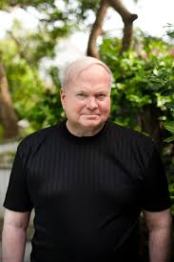
An enthusiastic reader, I have often been asked who my favorite writers are, a question I cannot answer easily for so many reasons. While attending college, I tended to like all the literature for each of the eras I studied with few exceptions, making it challenging to select one concentration for the doctoral program. Finally settling on Early American literature, I still think it sounds strange to tell others that some of my preferred authors are Puritan ministers, or seventeenth-century diarists. I also find it difficult to choose favorite authors because I have no real systematic reading method and no real hierarchy for the authors I like. I keep thinking that I will develop one. (Conroy photograph taken from http://www.chicagonow.com)
Pat Conroy, though, has provided many of my transcendent reading experiences so he is often the first writer whose name occurs to me when asked for a list of favorites. His status as a celebrated author is supremely well-deserved if we rate according to skill, passion, and soul. Now that he has died, I have to abandon the hope that I will attend one of his book-signings. I have heard from others who were privileged to meet him that he was warm, gracious, and humble, plus a few reports that he could be difficult at times. I am not surprised by the mix of qualities. If anyone has pondered and thoughtfully explored the human condition, it is Conroy.
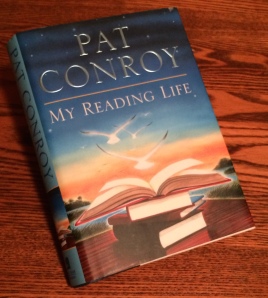
My Reading Life is a gem of a book. In it he writes that “the novels I’ve loved will live inside me forever.” He trusts “the great novelists to teach me how to live, how to feel, how to love and hate.” More poignant, now that he is gone, he trusted them:
“. . .to show me the dangers I will encounter on the road as I stagger on my own troubled passage through a complicated life of books that try to teach me how to die.”
He credits Margaret Mitchell’s novel, Gone With the Wind, for him becoming a novelist, noting that his mother read the novel to the children often, saw herself in it as the figure of Scarlett O’Hara, and raised him up to be a “Southern” novelist with an emphasis on the word “Southern.” He writes, “I owe a personal debt to this novel that I find almost beyond reckoning” (23).
Sometimes criticized for writing “purple” prose, Conroy’s descriptions are nonetheless beautiful, lyrical, and appealing. If you enjoy the literature of place, Conroy is your man. Here is a description from South of Broad, the first page.
“I carry the delicate porcelain beauty of Charleston like the hinged shell of some soft-tissued mollusk. My soul is peninsula-shaped and sun-hardened and river-swollen. The high tides of the city flood my consciousness each day, subject to the whims and harmonies of full moons rising out of the Atlantic. I grow calm when I see the ranks of palmetto trees pulling guard duty on the banks of Colonial Lake or hear the bells of St. Michael’s calling cadence in the cicada-filled trees along Meeting Street. Deep in my bones, I knew early that I was one of those incorrigible creatures known as Charlestonians.”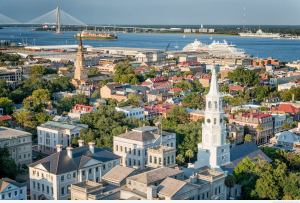 (Photo of Charleston, S.C. from http://www.awesomeplacesonearth.com)
(Photo of Charleston, S.C. from http://www.awesomeplacesonearth.com)
As he says in My Reading Life, he liked being “immersed in a made-up life lived at the highest pitch,” and that was my experience reading South of Broad and Beach Music, as well as his most famous book, The Prince of Tides.
Always interested in the habits of writers, I found his schedule in Paris to be appealing: morning writing, walk, lunch, nap, more writing (I would skip the nap, since they ruin me). He was there for four months and wrote six hundred handwritten pages (210). In general, he had an “ironclad” schedule of writing no matter where he lived, since writing books “does not permit much familiarity with chaos” (108). How I would love to escape my own tendency toward chaos and become more ironclad.
If I could get there, I would attend the exhibit at the University of South Carolina, a Pat Conroy Retrospective, which continues through the month of March. 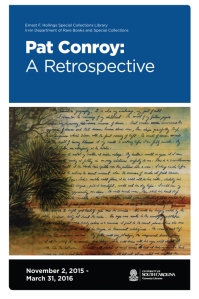 To say that he is an author that I “like” is understating my response to his books, but I wanted to avoid being sappy or overly-sentimental. I should point out that I had strong responses to his books, I LOVED his books, I was exhilarated by passages in his books, and I learned a lot about writing from his books. Rest in peace, Pat Conroy, and thank you for enhancing my appreciation for the reading experience, the writing experience, and for being a human being on earth at this time.
To say that he is an author that I “like” is understating my response to his books, but I wanted to avoid being sappy or overly-sentimental. I should point out that I had strong responses to his books, I LOVED his books, I was exhilarated by passages in his books, and I learned a lot about writing from his books. Rest in peace, Pat Conroy, and thank you for enhancing my appreciation for the reading experience, the writing experience, and for being a human being on earth at this time.
Find his blog and a list of his books on the website: Books by Pat Conroy.

 Film crews have been setting up all day to film at 5th Street and Flower just beside the library, and I have enjoyed watching them unload huge lights, gigantic cord spirals, and other items I do not recognize. Amplifiers and generators? Storage containers? Electric tools? They have built a structure that looks like a portion of the street after an explosion, and now they are spreading around a black powder that will likely produce some special effects. We were told by the hotel staff that there will be shooting sounds and a car explosion at 10 p.m. tonight. With such a lively and interesting view, I am writing, contentedly settled at the desk in our room, where I will be for several more hours.
Film crews have been setting up all day to film at 5th Street and Flower just beside the library, and I have enjoyed watching them unload huge lights, gigantic cord spirals, and other items I do not recognize. Amplifiers and generators? Storage containers? Electric tools? They have built a structure that looks like a portion of the street after an explosion, and now they are spreading around a black powder that will likely produce some special effects. We were told by the hotel staff that there will be shooting sounds and a car explosion at 10 p.m. tonight. With such a lively and interesting view, I am writing, contentedly settled at the desk in our room, where I will be for several more hours. I know many writers, poets, painters, and musicians, and as you would expect, they all have individual methods for their work, settings they like, environmental preferences. As Alexandra Enders noted in her article called “The Importance of Place: Where Writers Write and Why”:
I know many writers, poets, painters, and musicians, and as you would expect, they all have individual methods for their work, settings they like, environmental preferences. As Alexandra Enders noted in her article called “The Importance of Place: Where Writers Write and Why”: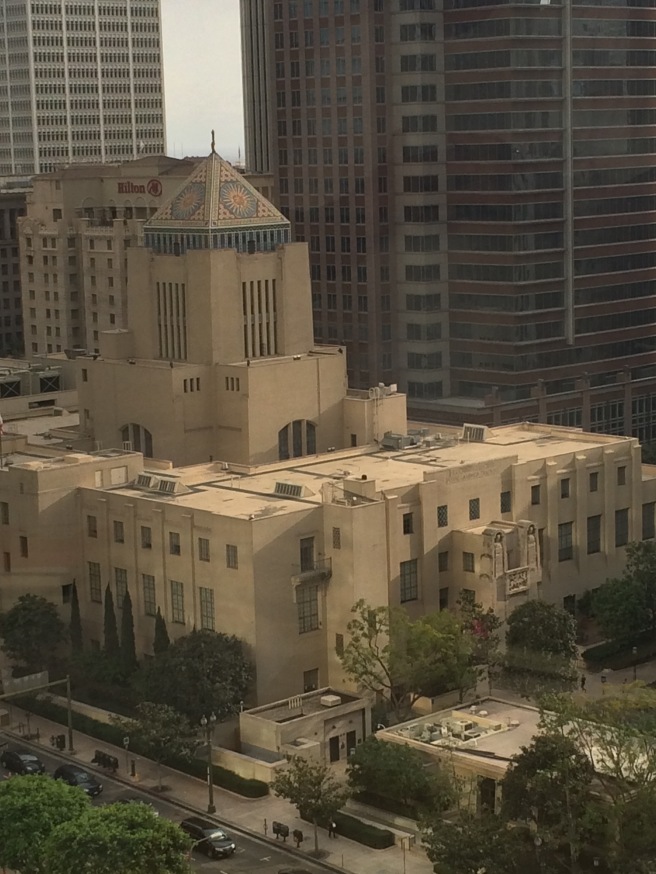 I am ultra-sensitive to the environment wherever I am. My long-suffering husband is the exact opposite. He can thrive and work almost anywhere, especially if he has a cup of coffee. My friends know that the ambiance in any given restaurant is supremely important, and it may take me a few minutes to select the right spot (away from bright light, chairs not too hard, tables not wobbly, tasteful décor, no brash TV noises, no traffic behind my chair). Thankfully, they usually allow me to select the space. My senses are so acute that loud noises can seem traumatic, bright light can feel like an assault, and the wrong person seated in the next booth or at the next table can ruin the day’s experience. At home, I can create the right environment, and when we are traveling or venturing out, I love it when an opportune setting is available. This desk at the Bonaventure is now a sacred spot, and as the sun and clouds shift and create new moods on the landscape, I am having a productive writing day.
I am ultra-sensitive to the environment wherever I am. My long-suffering husband is the exact opposite. He can thrive and work almost anywhere, especially if he has a cup of coffee. My friends know that the ambiance in any given restaurant is supremely important, and it may take me a few minutes to select the right spot (away from bright light, chairs not too hard, tables not wobbly, tasteful décor, no brash TV noises, no traffic behind my chair). Thankfully, they usually allow me to select the space. My senses are so acute that loud noises can seem traumatic, bright light can feel like an assault, and the wrong person seated in the next booth or at the next table can ruin the day’s experience. At home, I can create the right environment, and when we are traveling or venturing out, I love it when an opportune setting is available. This desk at the Bonaventure is now a sacred spot, and as the sun and clouds shift and create new moods on the landscape, I am having a productive writing day.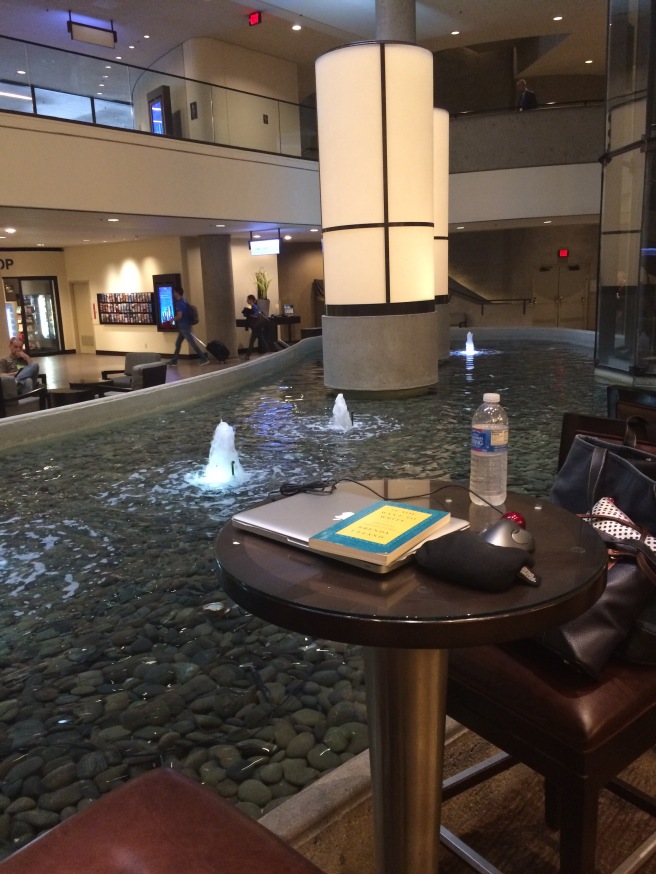 What is the setting in which you write? Are you particular or easygoing about your setting? Do you require certain accouterments? Whatever the case, we all seem to find our way through whatever impediments present themselves. Vive la différence!
What is the setting in which you write? Are you particular or easygoing about your setting? Do you require certain accouterments? Whatever the case, we all seem to find our way through whatever impediments present themselves. Vive la différence!